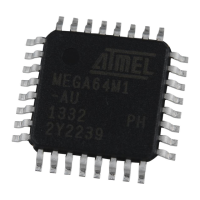174
7647H–AVR–03/12
Atmel ATmega16/32/64/M1/C1
16.2.5.3 Error Signalling
If one or more errors are discovered by at least one node using the above mechanisms, the cur-
rent transmission is aborted by sending an "error flag". This prevents other nodes accepting the
message and thus ensures the consistency of data throughout the network. After transmission
of an erroneous message that has been aborted, the sender automatically re-attempts
transmission.
16.3 CAN Controller
The CAN controller implemented into ATmega16/32/64/M1/C1 offers V2.0B Active.
This full-CAN controller provides the whole hardware for convenient acceptance filtering and
message management. For each message to be transmitted or received this module contains
one so called message object in which all information regarding the message (e.g. identifier,
data bytes etc.) are stored.
During the initialization of the peripheral, the application defines which messages are to be sent
and which are to be received. Only if the CAN controller receives a message whose identifier
matches with one of the identifiers of the programmed (receive-) message objects the message
is stored and the application is informed by interrupt. Another advantage is that incoming remote
frames can be answered automatically by the full-CAN controller with the corresponding data
frame. In this way, the CPU load is strongly reduced compared to a basic-CAN solution.
Using full-CAN controller, high baudrates and high bus loads with many messages can be
handled.

